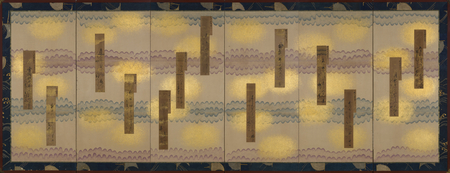Product Description
A pair of six-fold screens with applied tanzaku (poem slips) from the 17th century
Each tanzaku was executed by a court noble or priest of imperial lineage; they rest against a background of wavy horizontal lines in purple and blue, dispersed with sunago ‘clouds’ (sprinkled gold dust).
The boarder of this pair of screens is of particular interest as it is from an antique kimono textile with a design of sails. The screens were mounted by Nakagawa Chinkai of Kyoto.
Ink, colour and gold on paper
Poem slips 17th century Edo period; screens mounted in 1937
Dimensions: H. 107cm x W. 277cm (42¼” x 109”) each
Tomobako (original box): dated September 1937, signed Nakagawa Chinkai and sealed Chinkai
Tanzaku are rectangular sheets of paper used for calligraphic poems or paintings. Since the mid-Heian and Kamakura periods, such papers, termed shikishigata, were inscribed with poetic calligraphy and attached to screens or sliding door panels. Often these slips are highly decorated with gold or silver cut into small pieces or sprinkled like mist or finely painted with various motifs, as exemplified by the current example.
On this pair, some tanzaku are accompanied by slips inscribed with the names of kugyō (court nobles) and monzeki (priests of imperial lineage) from the 17th century who executed the calligraphy on the corresponding tanzaku.
Calligraphers of tanzaku on the right screen (from right to left, only where indicated):
– Minase Ujinari (1571-1644, court noble)
– Kawabata Sanetsura (1635-1706, court noble)
– Ōgimachi Kinmichi (1653-1733, court noble)
– Manshuin Ryōshō (1623-1693, head priest of Manshuin temple, Kyoto)
– Washinoo Takakazu (1606-1662, court noble)
– Takenaka Sueari (act. 17th 7803 century, court noble)
– Takakura Nagataka (1615-1681, court noble)
– Takenouchi Koretsune (1636-1704, court noble)
– Hiramatsu Tokitsune (1599-1654, court noble)
– Chikusa (unknown)
– Reizen Tametsune (1654-1722, court noble)
Calligraphers of tanzaku on the left screen (from right to left, only where indicated):
– Higuchi Nobutaka (1600-1658, court noble)
– Itsutsuji Toshinaka (1629-1657, court noble)
– Uramatsu Sukekiyo (1626-1667, court noble)
– Nakamikado Nobuyori (1613-1664, court noble)
– Sanjōnishi Sanenori (1619-1701, court noble)
– Enmanin Jōson (1604-1671, head priest of Enmanin temple, Shiga)
– Hamuro Yorinari (1615-1675, court noble)
– Tominokōji Yorinao (1613-1658, court noble) (appears twice on the fifth and sixth panels.)
Although not all the poems on the tanzaku are legible due to highly stylised and cursive characters, from what are legible, some might have been composed by the nobles at the time of the early 17th century but most seem to have been taken from the classical masterpieces of the Heian period (794-1192) and Kamakura period (1192-1333), such as Kokin-wakashū (Collection of Japanese Poems Ancient and Modern, compiled in the early 10th century) and Shin-kokin-wakashū (New Collection of Japanese Poems Ancient and Modern, compiled in the early 13th century). The themes are varied, yet they refer to the seasons and nature, as can be read from some of the poems below.
– Poem by Ōshikōchi no Mitsune (898-922), written by Kawabata Sanetsura
Tsukiyo ni wa
sore tomo miezu
ume no hana
ka o tazunetezo
shirubekarikeru
When the plums blended into
the moonlit night
I should have sought for
sweet fragrance
to find where the blossoms were
– Poem by Ariwara no Narihira (825-880), written by Ōgimachi Kinmichi
Yo no naka ni
taete sakura no
nakariseba
haru no kokoro wa
nodoke karamashi
If this world had never known
the ephemeral beauty
of cherry trees,
people’s hearts in spring
would have been calm and tranquil
– Poem by Ki no Tomonori (850-904), written by Hiramatsu Tokitsune
Akikaze ni
hatsukari ga ne zo
kikoyu naru
taga tamazusa o
kakete kitsuran
Cries of the first goose
floating on the autumn wind;
I wonder whose letter
he has carried
all the way from the north
– Poem by Kamo no Chōmei (1155-1216), written by Chikusa
Akikaze no
itari itaranu
sode wa araji
tada warekara no
tsuyu no yūgure
The autumn wind
blows across every sleeve;
yet my sleeve alone is
dampened with my tears
like evening dewfall
– Poem by Ki no Tomonori (850-904), written by Reizen Tametsune
Yuki fureba
ki goto ni hana zo
sakinikeru
izure o ume to
wakite oramashi
Snow has fallen
and piled on every tree;
how can I pick a plum branch
when the snow resembles
white blossoms?
– Poem by Minamoto no Shunrai (1055-1129), written by the unnamed
Asu mo kon
Noji no tamagawa
hagi koete
iro naru nami ni
tsuki yadori keri
I shall come tomorrow again
to the Jewel River of Noji
where waves behind bush clovers
reflect the colours of blossoms
and glitter under the moonlight
– Poem by Jakuren (1139-1202), written by Tominokōji Yorinao
Sabishisa wa
sono iro toshimo
nakarikeri
maki tatsu yama no
aki no yūgure
Sadness cannot be confined
to any specific colours
as the mountains with cypress
evoke sorrow
in this autumn evening
– Poem by Sakanoue no Korenori (act. early 10th century), written by Tominokōji Yorinao
Miyoshino no
yama no shirayuki
tsumoru rashi
furusato samuku
narimasaru nari
The while snow
must be piling up
on the Yoshino Mountain
as I feel bitter cold
in this ancient capital
n.b. Condition: Very Good
















